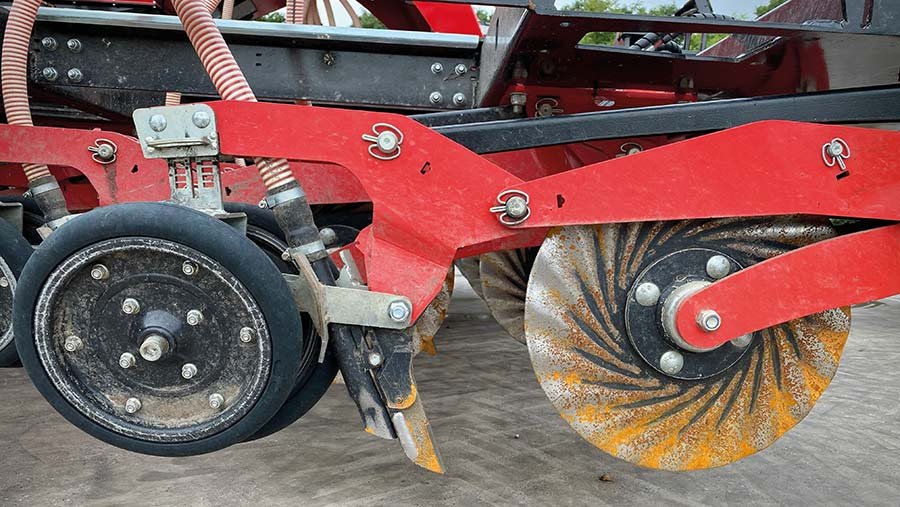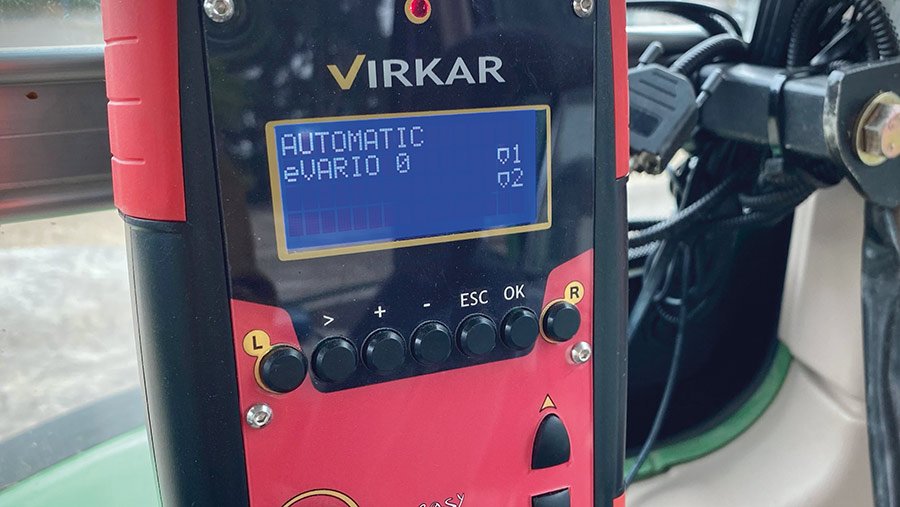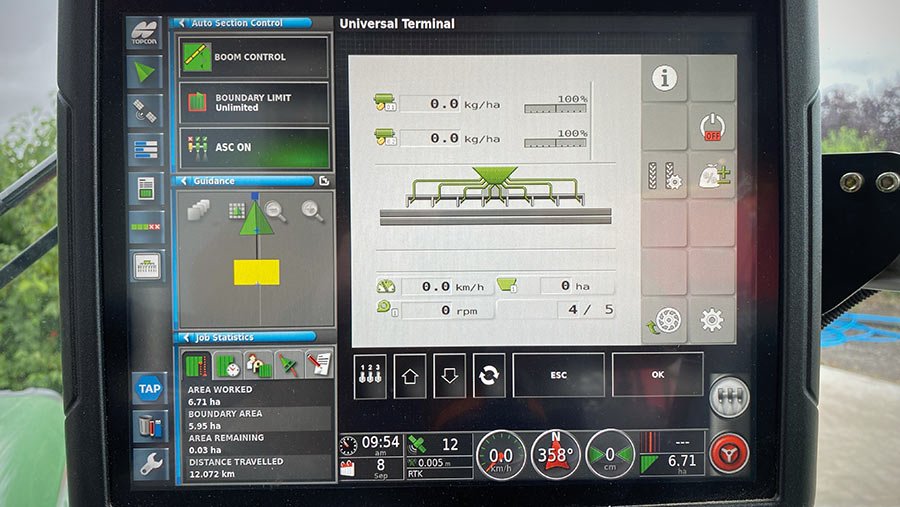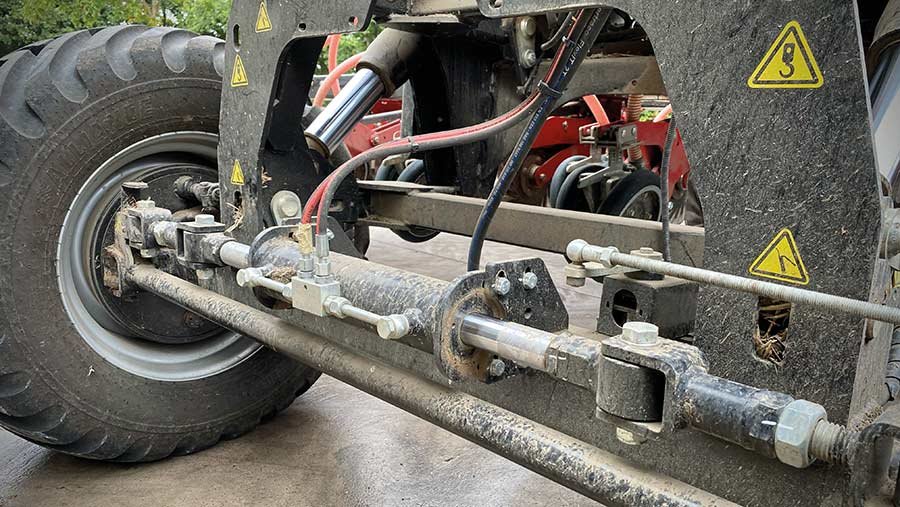We find out how Oxfordshire arable farmer Ralph Castle has been getting on after 18 months with a Virkar Dynamic drill, which is playing a central role in his effort to reduce blackgrass.
See also: Retrofit openers offer drill customisation on a budget
Farm facts: Home Mead Farm, Wantage, Oxfordshire
- Area 170ha
- Soils Varied, from green sand to clay
- Crops Winter and spring wheat, winter and spring barley, winter and spring beans
What made you choose a Virkar Dynamic DC?
Until 2014, I did some contract drilling alongside the farm, for which I covered up to 1,600ha annually with a Challenger and 8m Vaderstad Rapid.
But I gave it up to focus on my own land and downsized the Rapid to a Kockerling Jockey 600, which I subsequently ran for six years.
It’s basically an Allrounder tine-and-press cultivator with a hopper and metering system on the top.
Ralph Castle’s Virkar Dynamic DC
- Year 2021
- Width 6m
- Spacing 19mm
- Openers Turbo disc and following tine
- Hopper 5,300 litres, split 65/35
- Metering Accord system with Muller control unit
- Power requirement 180hp
- Drilling speed 8kph
- Price £80,000
Blackgrass has been a problem since the contracting days, so my approach was to encourage two weed flushes by twice making a pass with the Jockey as a cultivator (or a Kockerling tined PC), rolling it and spraying it off.
This was pushing my drilling date well into November and had little impact on the blackgrass, which just tended to adapt.
It also left no time to apply a pre-emergence herbicide, and the peri-em sprays were a waste of time and money.
© MAG/Oliver Mark
Wheat yields in some places were down to 5-6t/ha and, by 2020, I’d got to the point where something had to change.
I considered putting a chunk of the farm into grass and, as a last resort, even tried – and failed – to hoe between the wheat rows with the Jockey.
I’ve now changed tack, relying less on chemicals and more on mechanical weed control. That started with the drill.
I went to see a Claydon Hybrid and John Deere 750A on neighbouring farms and demoed a Horsch Avatar, which was good but expensive.
The 6m semi-mounted Virkar Dynamic DC was £15,000 cheaper, and I already knew Samagri through its Kockerling franchise – so I took a punt on that.
I’ve kept the Jockey, as the part exchange offer wasn’t worth it and it’ll be handy for putting in cover crops.
That was only part of the puzzle, though, and I also bought a 6m front-mounted Claydon Terrablade inter-row hoe.
At £10,000, it was one of the cheaper options, so it gave me a chance to try the system for a couple of years without throwing loads of money at it.
It has gone well, but I’m now looking to upgrade to something that’s a bit heavier-duty.
The vast amount of blackgrass I’m clearing sometimes blocks the lightweight hoe wings from getting into the ground – to the point that I have to unblock it in the hedge – and, in dry conditions, they tend to skim over the surface rather than break through the crust.
How does it work?
It’s a no-till drill, so I usually go straight into stubble or cover crops without any prior cultivations.
One of the options I specced was a set of slightly rippled ‘turbo’ discs that cut a channel and stir up a bit of tilth for the seed.
I have them spaced at 19cm – 3cm wider than the Jockey – but they can be switched to 25cm centres if necessary.

© MAG/Oliver Mark
Behind these, I upgraded to JJ Metcalfe’s 12mm-wide low-disturbance points to minimise soil movement. These clear most of the trash before the seed is dropped, and the slot is closed by a pair of V-formation rubber wheels.
Depth control is via a hole-and-pin system on each of the wheel assemblies, which is fine on the wings but means crawling underneath to get at the ones below the hopper.
I can then tweak the down-pressure of the discs to suit the ground conditions using a little Virkar control box in the cab.
The same box is used to engage the steering axle, which is locked for road transport but can be overridden for turning into a narrow gateway from the road, meaning the drill pretty much follows the path of the tractor.
It’s automatically engaged in the field, so I can turn tighter and leave a smaller three-bout headland – which is a nice perk when one lap of a big field can take 45mins.
I opted for a 65/35 split in the 5,000-litre hopper, with each compartment having its own Accord metering system.
The capacity suits me well as I work on my own and can load it up, do a morning’s work, then refill when I stop for lunch.
I haven’t used it to apply two products yet – I just load both compartments with seed and calibrate the metering so I can switch from one to the other – but it’s something I’ll experiment with once I’ve got the blackgrass under control.

© MAG/Oliver Mark
I run the metering controls through Isobus to a Topcon X35 screen, which I already had for the old drill, sprayer and fertiliser spreader.
This saved me buying the Muller unit offered with the drill – though the system isn’t particularly slick.

© MAG/Oliver Mark
How has it performed?
It’s still early days – it’s just starting its second autumn season and performance is difficult to assess, given that I’ve made so many other big changes to the establishment system at the same time.
I’m still trying to get my head around how to make the best of cover crops, which mixes to go for on the different soil types and when to drill them, so it’ll take a bit of trial and error to find the most effective approach.
The winter wheat did pretty well but the spring-sown crops were a bit more of a challenge.
The ground was wet and I hadn’t managed to get an over-winter cover crop in, so the discs cut a smeary slot and couldn’t create any tilth. A green cover would have made a massive difference.
On the heavier land, I’m going to use a Grange LDS every other year to break a soil pan about 75-100mm down – at least until I can get cover crop roots doing more of the work for me.
One thing I found early on with the Virkar is the importance of drilling speed.
I started out at 10kph – which is still less than the 12-14kph I did with the Jockey – but it was throwing too much soil about and defeating the objective of minimal disturbance.
I now stick to 8kph, which delivers far more consistent results and almost perfect seed placement.
It slices through cover crops too but, like most drills of this type, it doesn’t like too much chopped straw, which tends to bung up between the disc and tine.
What could be improved?
It’s got the makings of a good drill, but it’s still fairly new to the UK and Samagri is gradually tweaking things as it gets feedback.
For instance, the original slot-closing rubber tyres kept coming off the rims, so the whole lot was replaced.
And the pins on the press wheels have been swapped to nuts and bolts, as they were occasionally knocked out by big clods.
But it would also be nice to have some sort of break-back mechanism on the coulters. I’m quickly learning where all the big tree roots are, as they snap the point carriers clean off. I’ve now been through four of them.

© MAG/Oliver Mark
The Accord metering system is fine, but calibrating it is more of a faff than any other drill I’ve owned – and I’ve had a few.
It needs to be set incredibly accurately, which often means I go through the process five or six times with oilseed rape.
There’s not a lot of space to work under there either, so getting a bag in position is a challenge.
It’s also impossible to see the coulters underneath the hopper, so I’m going to mount a camera on the back to help spot any bung-ups a bit earlier, and the seed outlets sometimes block.
There’s no exhaust hole near the base of the pipe to maintain the air flow, so the seed stops flowing from the distribution head and, as I’ve got no blockage sensors, I tend to get out and check them every hour.
One other minor gripe is the sheet that covers the hopper, which shoots up like a sail when the wind gets under it.
Likes and Gripes
Likes
✔ Accurate seed placement
✔ Steering rear axle
✔ Cuts through thick cover crops
✔ Easy to adjust down-pressure
Gripes
✘ Tedious metering calibration
✘ No break-back leg protection
✘ Seed pipes occasionally block
✘ Flimsy hopper cover














